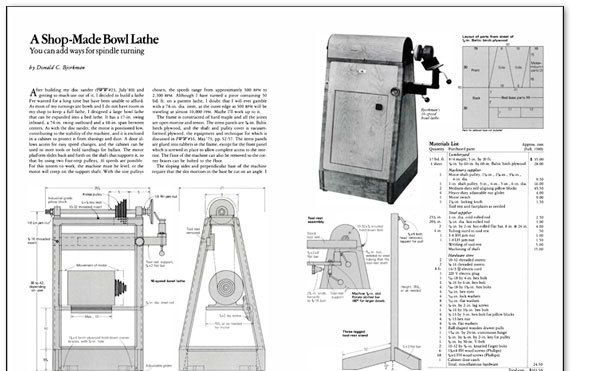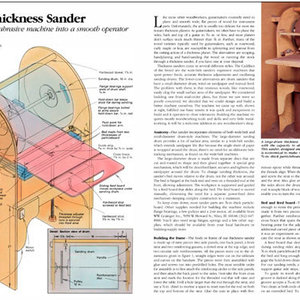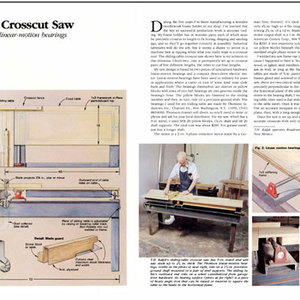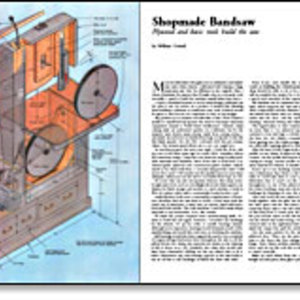
Synopsis: After building a disc sander and getting so much use out of it, I decided to build a lathe I’ve wanted for a long time but have been unable to afford. As most of my turnings are bowls and I do not have room in my shop to keep a full lathe, I designed a large bowl lathe that can be expanded into a bed lathe. It has a 17-in. swing inboard, a 74-in. swing outboard and a 48-in. span between centers. As with the disc sander, the motor is poisitioned low, contributing to the stability of the machine, and it is enclosed in a cabinet to protect it from shavings and dust. A door allows access for easy speed changes, and the cabinet can be used to store tools or hold sandbags for ballast. The motor platform slides back and forth on the shaft that supports it, so that by using two four-step pulleys, 16 speeds are possible.
After building my disc sander (FWW#2 3, July ‘ 80) and getting so much use out of it, I decided to build a lathe I’ve wanted for a long time but have been unable to afford. As most of my turnings are bowls and I do not have room in my shop to keep a full lathe, I designed a large bowl lathe that can be expanded into a bed lathe. It has a 1 7-in. swing inboard, a 74-in. swing outboard and a 48-in. span between centers. As with the disc sander, the motor is positioned low, contributing to the stability of the machine, and it is enclosed in a cabinet to protect it from shavings and dust. A door allows access for easy speed changes, and the cabinet can be used to store tools or hold sandbags for ballast. The motor platform slides back and forth on the shaft that supports it, so that by using two four-step pulleys, 16 speeds are possible. For this system to work, the machine must be level, or the motor will creep on the support shaft. With the size pulleys chosen, the speeds range from approximately 500 RPM to 2,300 RPM. Although I have turned a piece containing 50 bd. ft. on a pattern lathe, I doubt that I will ever gamble with a 74-in. dia. item, as the outer edge at 500 RPM will be traveling at almost 10,000 FPM. Maybe I’ll work up to it.
The frame is constructed of hard maple and all the joints are open mortise and tenon. The stress panels are %-in. Baltic birch plywood, and the shaft and pulley cover is vacuumformed plywood, the equipment and technique for which is discussed in FWW#16, May ’79, pp. 52-57. The stress panels are glued into rabbets in the frame, except for the front panel which is screwed in place to allow complete access to the interior. The floor of the machine can also be removed so the corner braces can be bolted to the floor.
For the full article, download the PDF below:

















Log in or create an account to post a comment.
Sign up Log in